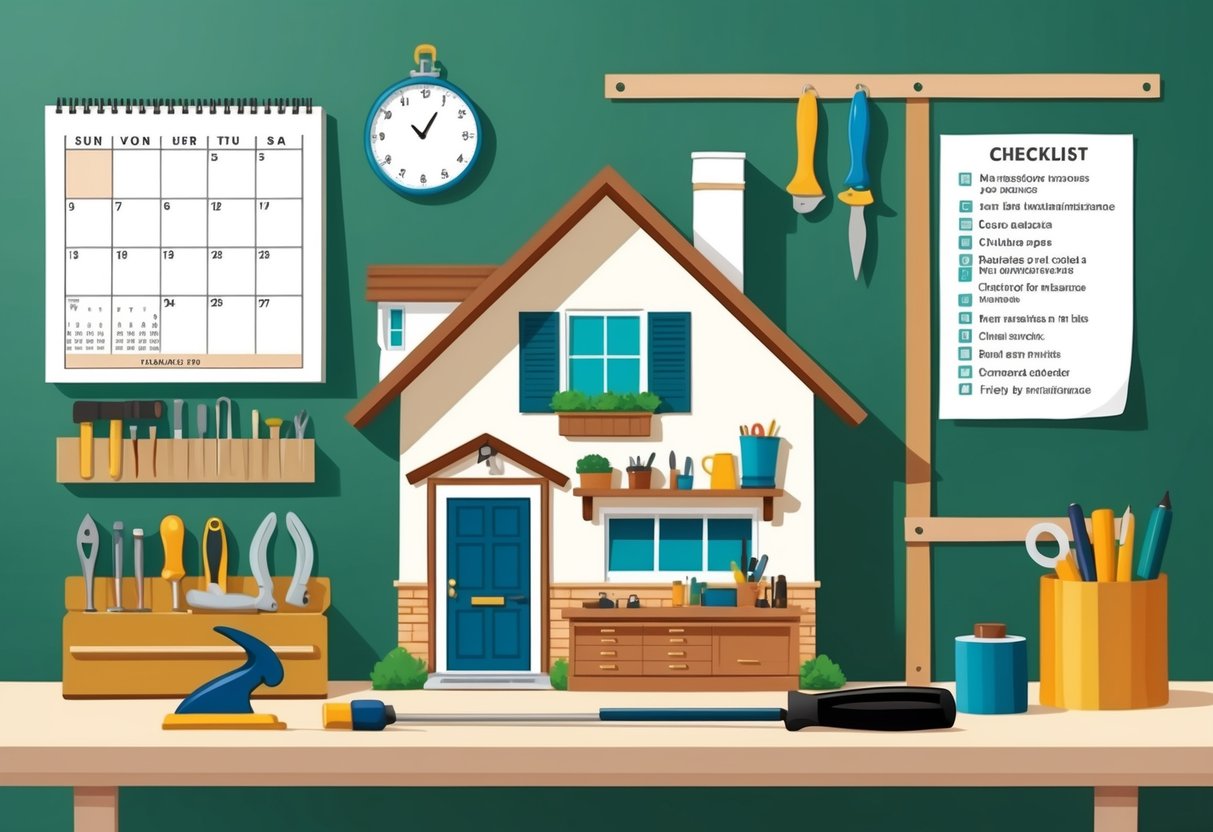
A well-planned preventative home maintenance schedule can save homeowners significant money by catching small issues before they become expensive repairs.
By proactively maintaining key systems and regularly inspecting for wear and tear, homeowners can extend the life of appliances, minimize unexpected costs, and ensure a safer living environment.
Preventative home maintenance also protects a property’s value, helping avoid costly emergencies that could disrupt daily life.
Creating a consistent home maintenance schedule doesn’t have to be overwhelming.
With the right plan in place, tasks like checking HVAC filters, inspecting roofs, and servicing plumbing can be organized into manageable checklists.
Many experts recommend budgeting between one and three percent of a home’s value each year for maintenance to avoid larger expenses later, as outlined in a comprehensive maintenance checklist.
Preventative home maintenance isn’t just about fixing what’s broken; it’s about taking control of the upkeep process.
Whether someone is a new homeowner or experienced with property care, learning how to set up a customized maintenance schedule empowers them to save money over the long term while keeping their home in optimal condition.
Understanding the Importance of Preventative Home Maintenance
Maintaining a proactive approach to home care helps property owners avoid unnecessary financial strain, protects family health, and supports long-term home value.
Routine maintenance targets key systems and structures that impact daily living, comfort, and expenses.
Cost Savings and Avoiding Costly Repairs
Addressing small issues through scheduled maintenance often prevents them from becoming expensive emergencies.
For instance, regular HVAC servicing, cleaning gutters, and inspecting roofing can catch issues before they require a complete replacement—saving hundreds or even thousands of dollars.
According to Prefix, a home preventative maintenance schedule is designed to keep major systems working smoothly, which delays large-scale repairs.
Budget-friendly habits include tasks such as changing air filters, checking plumbing for leaks, and sealing gaps to prevent drafts.
These steps minimize the risk of water damage, mold, and escalating repair bills.
Homeowners who practice regular upkeep tend to face fewer surprises and retain better financial control.
Protecting Home and Family Health
Scheduled maintenance is critical for a safe and comfortable living environment.
Tasks like testing smoke alarms, monitoring for mold or mildew, and replacing HVAC filters help ensure air quality and reduce fire risks.
Clean and well-maintained homes lower the chance of respiratory problems and allergic reactions among family members.
Many hazards, including carbon monoxide leaks, pest infestations, and electrical issues, can be detected through routine inspections.
As emphasized by NC State Extension, good home maintenance procedures enhance overall safety and comfort for everyone residing in the house.
Environmental Impact and Long-Term Value
Preventative maintenance has positive effects on the environment and the home’s long-term worth.
When appliances and systems run efficiently, energy and water use are reduced, resulting in smaller utility bills and a lighter environmental footprint.
Weatherproofing, efficient insulation, and eco-friendly upgrades contribute to sustainability efforts.
Consistent upkeep helps preserve the home’s structure and curb appeal, which can be important for resale value.
Real estate buyers often look for properties with a documented history of proper care.
Homeowners who invest time in preventative measures may avoid the depreciation related to deferred maintenance, while also promoting eco-friendly home operations as outlined in many maintenance checklists by home improvement experts.
Establishing Your Home Maintenance Goals
Effective home maintenance goals provide structure and clarity, allowing homeowners to address urgent concerns first, plan for unique property requirements, and dedicate resources efficiently.
With clear goals, maintenance tasks become more manageable and can help save money by preventing large, costly repairs.
Identifying Priorities
The first step is to categorize which systems and areas of the home demand immediate attention.
Most homeowners place core infrastructure—such as the roof, HVAC systems, plumbing, and electrical—at the top of their list due to cost implications if failures occur.
Next, identify recurring maintenance tasks like replacing HVAC filters, inspecting gutters, or checking for leaks.
Grouping items by frequency—monthly, quarterly, or annually—helps ensure nothing is overlooked.
For instance, regular HVAC filter changes and annual gutter cleanings are essential for maintaining system efficiency and preventing expensive damage.
A checklist can boost consistency:
| Priority Level | Example Tasks | Frequency |
|---|---|---|
| High | Roof inspection, HVAC service | Annually |
| Medium | Gutter cleaning, caulking | 1-2 times/year |
| Low | Interior paint touch-ups | As needed |
Assessing Your Home’s Unique Needs
Each home is different, and maintenance goals should reflect its specific requirements.
Home construction materials, age, location, and past repairs all influence what needs attention and how often.
For properties in regions with harsh winters, tasks such as winterizing plumbing and sealing windows become high priority.
Older houses may demand more frequent checks of foundations or historical features.
Environmental factors, such as heavy rain or humidity, can dictate the need for mold inspections or sump pump testing.
Conduct a thorough walk-through once per year and after severe weather events.
Look for subtle issues like damp spots, peeling paint, or abnormal noises from mechanical systems.
A full assessment not only highlights problem areas but also helps set reasonable expectations for ongoing property care.
Setting a Budget
A realistic budget will guide every maintenance decision and help homeowners allocate funds where they are needed most.
Experts often recommend saving 1-4% of a home’s value annually for maintenance, though this figure may need adjustment based on age, size, and condition.
Begin by listing routine and preventative tasks, grouping them by timeframe and anticipated cost.
This lets owners estimate annual and seasonal expenditures.
For major systems, establish a savings plan to cover eventual big-ticket items like roof replacement or HVAC upgrades.
For a step-by-step guide to creating a maintenance budget, assess current home conditions and adjust projections as needs change.
Homeowners can stretch their budgets further by investing in basic tools, reusing leftover materials, and seeking discounts on supplies when appropriate.
Regularly reviewing spending and adjusting plans encourages long-term savings and helps prevent unexpected financial burdens.